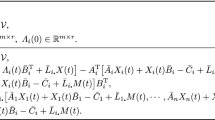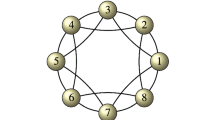Abstract
This paper proposes a novel distributed optimization algorithm with fractional order dynamics to solve linear algebraic equations. Firstly, the authors proposed “Consensus + Projection” flow with fractional order dynamics, which has more design freedom and the potential to obtain a better convergent performance than that of conventional first order algorithms. Moreover, the authors prove that the proposed algorithm is convergent under certain iteration order and step-size. Furthermore, the authors develop iteration order switching scheme with initial condition design to improve the convergence performance of the proposed algorithm. Finally, the authors illustrate the effectiveness of the proposed method with several numerical examples.
Similar content being viewed by others
References
Hui Q, Haddad W M, and Bhat S P, Semistability, finite-time stability, differential inclusions, and discontinuous dynamical systems having a continuum of equilibria, IEEE Transactions on Automatic Control, 2009, 54(10): 2465–2470.
Chen C T, Introduction to the linear algebraic method for control system design, IEEE Control Systems Magazine, 1987, 7(5): 36–42.
Zhu S Y, Chen C L, Xu J M, et al., Mitigating quantization effects on distributed sensor fusion: A least squares approach, IEEE Transactions on Signal Processing, 2018, 66(13): 3459–3474.
Braunstein A, Muntoni A P, Pagnani A, et al., Compressed sensing reconstruction using expectation propagation, Journal of Physics A: Mathematical and Theoretical, 2020, 53(18): 184001.
Dafchahi F N, A new refinement of Jacobi method for solution of linear system equations Ax = b, International Journal of Contemporary Mathematical Sciences, 2008, 3(17): 819–827.
Vatti V and Gonfa G G, Refinement of generalized Jacobi (RGJ) method for solving system of linear equations, International Journal of Contemporary Mathematical Sciences, 2011, 6(3): 109–116.
Hurt J, Some stability theorems for ordinary difference equations, SIAM Journal on Numerical Analysis, 1967, 4(4): 582–596.
Ortega J M and Rockoff M L, Nonlinear difference equations and Gauss-Seidel type iterative methods, SIAM Journal on Numerical Analysis, 1966, 3(3): 497–513.
Wen Z W, Yin W T, and Zhang Y, Solving a low-rank factorization model for matrix completion by a nonlinear successive over-relaxation algorithm, Mathematical Programming Computation, 2012, 4(4): 333–361.
Allahviranloo T, Successive over relaxation iterative method for fuzzy system of linear equations, Applied Mathematics and Computation, 2005, 162(1): 189–196.
Yi P and Hong Y G, Distributed cooperative optimization and its applications, Scientia Sinica Mathematica, 2016, 46(10): 1547–1564.
Yang T, Yi X L, Wu J F, et al., A survey of distributed optimization, Annual Reviews in Control, 2019, 47: 278–305.
Shi W, Ling Q, Wu G, et al., Extra: An exact first-order algorithm for decentralized consensus optimization, SIAM Journal on Optimization, 2015, 20(2): 944–966.
Cheng S S, Liang S, and Fan Y, Distributed solving Sylvester equations with fractional order dynamics, Control Theory and Technology, 2021, 19(2): 249–259.
Mo L P, Liu X D, Cao X B, et al., Distributed second-order continuous-time optimization via adaptive algorithm with nonuniform gradient gains, Journal of Systems Science and Complexity, 2020, 33(6): 1914–1932.
Wang J X, Fu K L, Gu Y, et al., Convergence of distributed gradient-tracking-based optimization algorithms with random graphs, Journal of Systems Science and Complexity, 2021, 34(4): 1438–1453.
Yi P and Li L, Distributed nonsmooth convex optimization over Markovian switching random networks with two step-sizes, Journal of Systems Science and Complexity, 2021, 34(1): 1–21.
Liang S, Zeng X L, and Hong Y G, Distributed nonsmooth optimization with coupled inequality constraints via modified Lagrangian function, IEEE Transactions on Automatic Control, 2017, 63(6): 1753–1759.
Zeng X L, Yi P, and Hong Y G, Distributed continuous-time algorithm for constrained convex optimizations via nonsmooth analysis approach, IEEE Transactions on Automatic Control, 2016, 62(10): 5227–5233.
Yuan D M, Hong Y G, Daniel W C H, et al., Optimal distributed stochastic mirror descent for strongly convex optimization, Automatica, 2018, 90: 196–203.
Wang Y H, Zhao W X, Hong Y G, et al., Distributed subgradient-free stochastic optimization algorithm for nonsmooth convex functions over time-varying networks, SIAM Journal on Control and Optimization, 57(4): 2821–2842.
Benner P and Breiten T, On optimality of approximate low rank solutions of large-scale matrix equations, Systems & Control Letters, 2014, 67: 55–64.
Mou S S, Liu J, and Morse A S, A distributed algorithm for solving a linear algebraic equation, IEEE Transactions on Automatic Control, 2015, 63(11): 2863–2878.
Liu J, Mou S S, and Morse A S, Asynchronous distributed algorithms for solving linear algebraic equations, IEEE Transactions on Automatic Control, 2017, 63(2): 372–385.
Lei J L, Yi P, Shi G D, et al., Distributed algorithms with finite data rates that solve linear equations, SIAM Journal on Optimization, 2020, 30(2): 1191–1222.
Shi G D, Anderson B D O, and Helmke U, Network flows that solve linear equations, IEEE Transactions on Automatic Control, 2017, 62(6): 2659–2674.
Deng W, Zeng X L, and Hong Y G, Distributed computation for solving the Sylvester equation based on optimization, IEEE Control Systems Letters, 2019, 4(2): 414–419.
Zeng X L, Liang S, Hong Y G, et al., Distributed computation of linear matrix equations: An optimization perspective, IEEE Transactions on Automatic Control, 2018, 64(5): 1858–1873.
Bhaya A and Kaszkurewicz E, Steepest descent with momentum for quadratic functions is a version of the conjugate gradient method, Neural Networks, 2004, 17(1): 65–71.
Muehlebach M and Jordan M, A dynamical systems perspective on Nesterov acceleration, International Conference on Machine Learning, PMLR, 2019.
Su W J, Boyd S, and Candès E J, A differential equation for modeling Nesterov’s accelerated gradient method: Theory and insights, Journal of Machine Learning Research, 2016, 17: 1–43.
Wei Y H, Gao Q, Cheng S S, et al., Description and analysis of the time domain response of nabla discrete fractional order systems, Asian Journal of Control, 2020, 23(4): 1911–1922.
Wang Y and Liang S, Two-DOF lifted LMI conditions for robust D-stability of polynomial matrix polytopes, International Journal of Control, Automation and Systems, 11(3): 636–642.
Li Y L, Meng X, Zheng B C, et al., Parameter identification of fractional order linear system based on Haar wavelet operational matrix, ISA Transactions, 2015, 59: 79–84.
Wei Y H and Chen Y Q, Converse Lyapunov theorem for nabla asymptotic stability without conservativeness, IEEE Transactions on Systems, Man, and Cybernetics: Systems, DOI: https://doi.org/10.1109/TSMC.2021.3051639, 2021.
Wei Y H, Lyapunov stability theory for nonlinear nabla fractional order systems, IEEE Transactions on Circuits and Systems II: Express Briefs, DOI: https://doi.org/10.1109/TCSII.2021.3063914, 2021.
Lu J G and Chen G R, Robust stability and stabilization of fractional order interval systems: An LMI approach, IEEE Transactions on Automatic Control, 2009, 54(6): 1294–1299.
Chen L P, He Y G, Chai Y, et al., New results on stability and stabilization of a class of nonlinear fractional order systems, Nonlinear Dynamics, 2014, 75(4): 633–641.
Wei Y Q, Liu D Y, Boutat D, et al., Modulating functions based model-free fractional order differentiators using a sliding integration window, Automatica, 2021, 130: 109679.
Sheng H, Chen Y Q, and Qiu T S, Fractional Processes and Fractional-order Signal Processing: Techniques and Applications, Springer Science & Business Media, Berlin, 2011.
Alieva T and Bastiaans M J, On fractional Fourier transform moments, IEEE Signal Processing Letters, 2000, 7(11): 320–323.
Li H S, Luo Y, and Chen Y Q, A fractional order proportional and derivative (FOPD) motion controller: Tuning rule and experiments, IEEE Transactions on Control Systems Technology, 2009, 18(2): 516–520.
Cheng S S, Wei Y H, Chen Y Q, et al., A universal modified LMS algorithm with iteration order hybrid switching, ISA Transactions, 2017, 67: 67–75.
Podlubny I, Fractional Differential Equations: An Introduction to Fractional Derivatives, Fractional Differential Equations, to Methods of Their Solution and Some of Their Applications, Elsevier, Academic Press, San Diego, 1998.
Chen Y Q, Vinagre B M, and Podlubny I, Continued fraction expansion approaches to discretizing fractional order derivatives-an expository review, Nonlinear Dynamics, 2004, 38(1): 155–170.
Author information
Authors and Affiliations
Corresponding author
Additional information
This work was supported by the National Natural Science Foundation of China under Grant Nos. 62103003, 62073001, and 61973002, the Anhui Provincial Key Research and Development Project under Grant 2022i01020013, the University Synergy Innovation Program of Anhui Province under Grant No. GXXT-2021-010, the Anhui Provincial Natural Science Foundation under Grant No. 2008085J32, the National Postdoctoral Program for Innovative Talents under Grant No. BX20180346, and the General Financial Grant from the China Postdoctoral Science Foundation under Grant No. 2019M660834.
Rights and permissions
About this article
Cite this article
Yu, W., Cheng, S. & He, S. Distributed Solving Linear Algebraic Equations with Switched Fractional Order Dynamics. J Syst Sci Complex 36, 613–631 (2023). https://doi.org/10.1007/s11424-023-1350-6
Received:
Revised:
Published:
Issue Date:
DOI: https://doi.org/10.1007/s11424-023-1350-6




